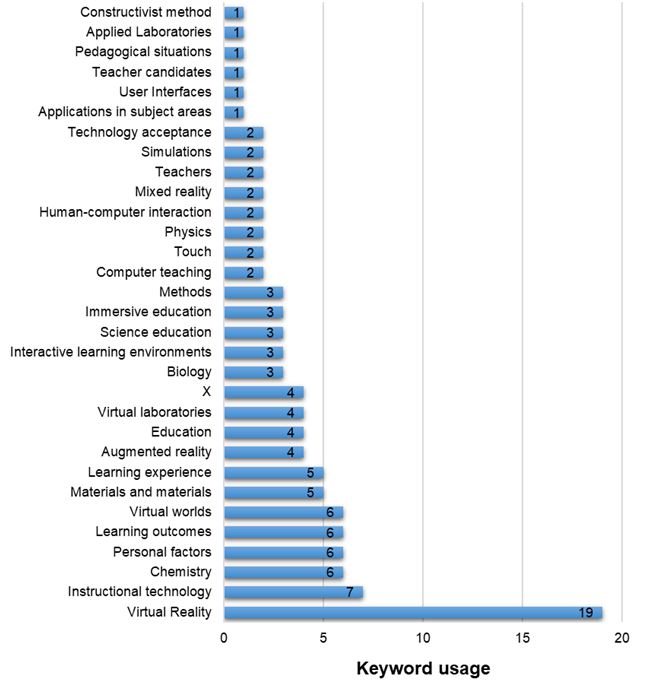
Virtual Reality in Science Education: a Descriptive Review
Abstract
Full Text:
DOWNLOAD PDFReferences
Akçayır, M., & Akçayır, G. (2017). Advantages and challenges associated with augmented reality for education: A systematic review of the literature. Educational Research Review, 20, 1-11. doi:10.1016/j.edurev.2016.11.002
Allcoat, D., & von Mühlenen, A. (2018). Learning in virtual reality: Effects on performance, emotion and engagement. Research in Learning Technology, 26(0). doi:10.25304/rlt.v26.2140
Barnett, M., Yamagata-Lynch, L., Keating, T., Barab, S. A., & Hay, K. E. (2005). Using virtual reality computer models to support student understanding of astronomical concepts. Journal of Computers in Mathematics and Science Teaching, 24(4), 333-356.
Bortnik, B., Stozhko, N., Pervukhina, I., Tchernysheva, A., & Belysheva, G. (2017). Effect of virtual analytical chemistry laboratory on enhancing student research skills and practices. Research in Learning Technology, 25(0). doi:10.25304/rlt.v25.1968
Bowman, D. A., & McMahan, R. P. (2007). Virtual reality: How much immersion Is enough? Computer, 40(7), 36-43. doi:10.1109/mc.2007.257
Çalışkan, E. (2017). Eğitimde yenilikçi teknolojilerin kullanımı açısından Türkiye’de son beş yıl içerisinde (2011-2015) tamamlanmış lisansüstü tezlerin incelenmesi. Journal of Human Sciences, 14(1), 496-505. doi:10.14687/jhs.v14i1.4169
Checa, D., & Bustillo, A. (2019). A review of immersive virtual reality serious games to enhance learning and training. Multimedia Tools and Applications, 79(9-10), 5501-5527. doi:10.1007/s11042-019-08348-9.
Durukan, A. (2018). Sanal gerçeklikle zenginleştirilmiş öğrenme ortamının fen bilimleri öğretmen adayları üzerindeki etkilerinin incelenmesi. (Yüksek lisans Yayınlanmamış yüksek lisans tezi). Van Yüzüncü Yıl Üniversitesi, Van. (10214486).
Durukan, A., Temur, A., & Artun, H. (2018). Fen bilimleri öğretmen adaylarının sanal gerçeklik destekli mikroöğretim uygulamaları: Bir akran değerlendirme çalışması. Paper presented at the 2. Uluslararası Türk Dünyası Eğitim Bilimleri ve Sosyal Bilimler Kongresi, Antalya.
Galvan, J. L., & Galvan, M. C. (2017). Writing Literature Reviews: A Guide for Students of the Social and Behavioral Sciences: Taylor & Francis.
Hamidi, F., Ghorbandordinejad, F., Rezaee, M., & Jafari, M. (2011). A comparison of the use of educational technology in the developed/developing countries. Paper presented at the Procedia Computer Science.
Hew, K. F., & Cheung, W. S. (2010). Use of three-dimensional (3-D) immersive virtual worlds in K-12 and higher education settings: A review of the research. British Journal of Educational Technology, 41(1), 33-55. doi:10.1111/j.1467-8535.2008.00900.x
Inman, C., Wright, V. H., & Hartman, J. A. (2010). Use of Second Life in K-12 and higher education: A review of research. Journal of Interactive Online Learning, 9(1), 44-63.
Jensen, L., & Konradsen, F. (2017). A review of the use of virtual reality head-mounted displays in education and training. Education and Information Technologies, 23(4), 1515-1529. doi:10.1007/s10639-017-9676-0
Kavanagh, S., Luxton-Reilly, A., Wuensche, B., & Plimmer, B. (2017). A systematic review of virtual reality in education. Themes in Science and Technology Education, 10(2), 85-119.
Kim, S. H., Lee, J. L., & Thomas, M. K. (2012). Between purpose and method: A review of educational research on 3D virtual worlds. Journal For Virtual Worlds Research, 5(1). doi:10.4101/jvwr.v5i1.2151
Lee, E. A.-L., & Wong, K. W. (2008). A Review of Using Virtual Reality for Learning. In Z. Pan, A. D. Cheok, W. Müller, & A. El Rhalibi (Eds.), Transactions on Edutainment I (pp. 231-241). Berlin, Heidelberg: Springer Berlin Heidelberg.
Lee, E. A.-L., Wong, K. W., & Fung, C. C. (2010). How does desktop virtual reality enhance learning outcomes? A structural equation modeling approach. Computers & Education, 55(4), 1424-1442. doi:10.1016/j.compedu.2010.06.006.
Linn, M. C. (2003). Technology and science education: starting points, research programs, and trends. International Journal of Science Education, 25(6), 727-758. doi:10.1080/0950069032000076670.
Liu, D., Bhagat, K. K., Gao, Y., Chang, T.-W., & Huang, R. (2017). The Potentials and Trends of Virtual Reality in Education. In D. Liu, C. Dede, R. Huang, & J. Richards (Eds.), Virtual, Augmented, and Mixed Realities in Education (pp. 105-130). Singapore: Springer Singapore.
Ma, J., & Nickerson, J. V. (2006). Hands-on, simulated, and remote laboratories: A comparative literature review. ACM Comput. Surv., 38(3), 7. doi:10.1145/1132960.1132961.
Mikropoulos, T. A., & Natsis, A. (2011). Educational virtual environments: A ten-year review of empirical research (1999–2009). Computers & Education, 56(3), 769-780. doi:10.1016/j.compedu.2010.10.020
Mora, C. E., Martín-Gutiérrez, J., Añorbe-Díaz, B., & González-Marrero, A. (2017). Virtual technologies trends in education. Eurasia Journal of Mathematics, Science and Technology Education, 13(1), 469-486. doi:10.12973/eurasia.2017.00626a
Nalbant, G., & Bostan, B. (2006). Interaction in virtual reality. Paper presented at the 4th International Symposium of Interactive Medial Design (ISIMD).
Nissim, Y., & Weissblueth, E. (2017). Virtual reality (VR) as a source for self-efficacy in teacher training. International Education Studies, 10(8), 52. doi:10.5539/ies.v10n8p52.
Padilla, M. J. (1990). The science process skills. Retrieved from https://www.narst.org/publications/research/skill.cfm.
Scimago Lab. (2019, 2019/02/22/). SJR - International Science Ranking. Country Rankings. https://www.scimagojr.com/countryrank.php?area=3300&category=3304.
Trindade, J., Fiolhais, C., & Almeida, L. (2002). Science learning in virtual environments: a descriptive study. British Journal of Educational Technology, 33(4), 471-488. doi:10.1111/1467-8535.00283.
Tuysuz, C. (2010). The effect of the virtual laboratory on students’ achievement and attitude in chemistry. International Online Journal of Educational Sciences, 2(1), 37-53.
Whitelock, D., Brna, P., & Holland, S. (1996). What is the value of virtual reality for conceptual learning? Towards a theoretical framework. Paper presented at the Proceedings of the European Conference on Artificial Intelligence in Education, Ediçöes Colibri, Lisboa, Portugal.
Yen, J.-C., Tsai, C.-H., & Wu, M. (2013). Augmented reality in the higher education: Students’ science concept learning and academic achievement in astronomy. Procedia - Social and Behavioral Sciences, 103, 165-173. doi:10.1016/j.sbspro.2013.10.322.
Young, S., & Nichols, H. (2017). A reflexive evaluation of technology-enhanced learning. Research in Learning Technology, 25(0), 13. doi:10.25304/rlt.v25.1998.
Yumuşak, A., & Aycan, Ş. (2002). Fen bilgisi eğitiminde bilgisayar destekli çalışmanın faydaları; Demirci (Manisa)'de bir örnek. M.Ü. Atatürk Eğitim Fakültesi Eğitim Bilimleri Dergisi, 16, 197-204.
DOI: https://doi.org/10.17509/jsl.v3i3.21906
Refbacks
- There are currently no refbacks.
Copyright (c) 2020 Alper DURUKAN, Huseyin ARTUN, Atilla TEMUR

This work is licensed under a Creative Commons Attribution-ShareAlike 4.0 International License.


Jl. Dr. Setiabudhi 229 Bandung 40154, West Java, Indonesia










